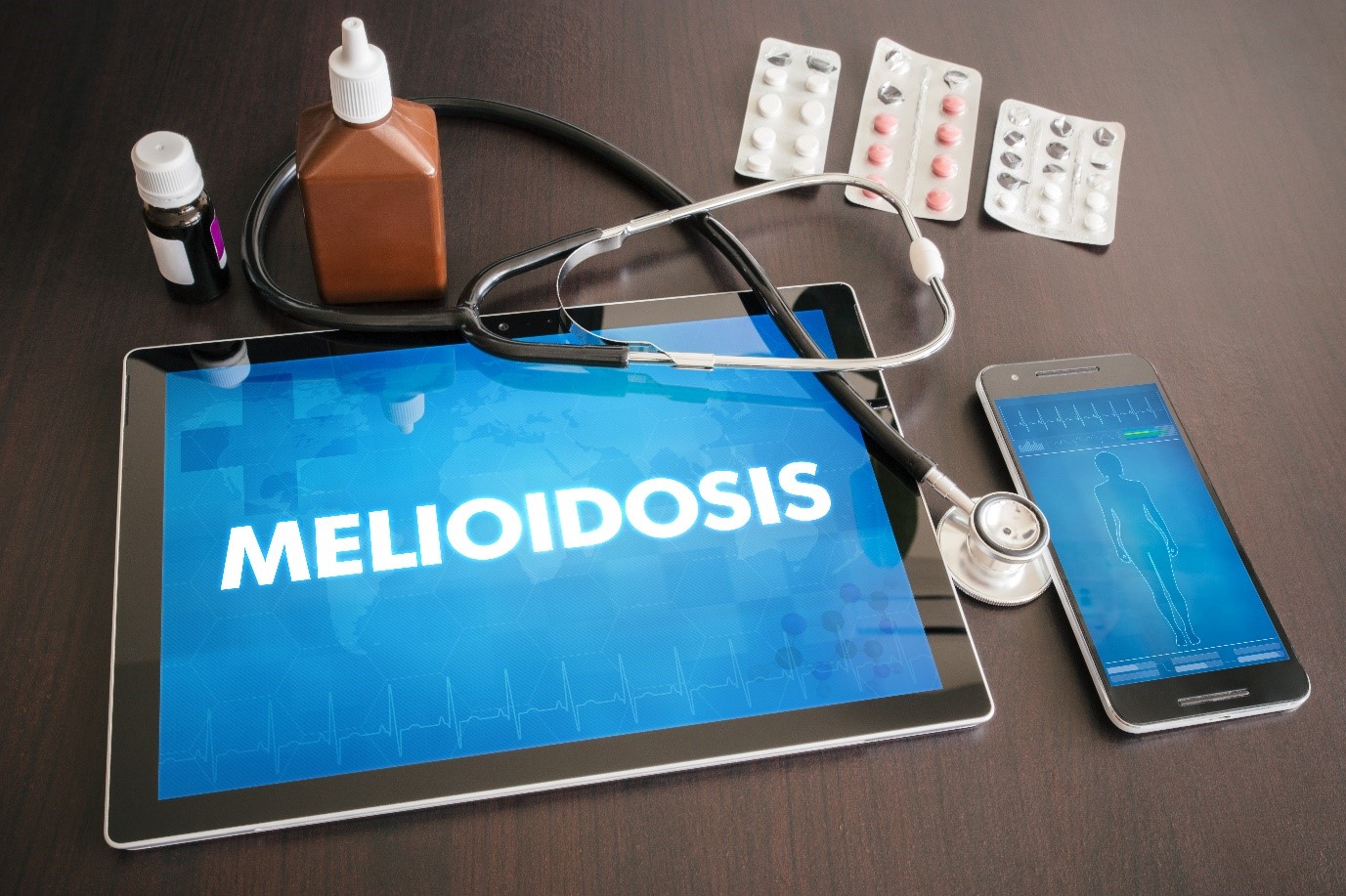Melioidosis
8 NOV 2022
 Wing Yan Jacqueline Tam, Pawel Beczkowski and Vanessa R. Barrs
Wing Yan Jacqueline Tam, Pawel Beczkowski and Vanessa R. Barrs
Centre for Animal Health and Welfare, City University of Hong Kong
A recent cluster of cases of melioidosis, a bacterial infection caused by
Burkholderia pseudomallei, has been reported in Hong Kong. The bacteria responsible for melioidosis are saprophytes, found in soil and muddy water and are endemic in Hong Kong, as well as South East Asia (Thailand, Singapore) and the Northern Territory of Australia. The cluster of 34 cases in Hong Kong has been focused in Sham Shui Po, and is thought to be associated with contaminated soil entering the West Kowloon reservoir and/or disturbed soil in construction sites.
Melioidosis can affect humans and a wide range of animals
1. Infection primarily occurs through contact, ingestion or inhalation of contaminated soil or water, while horizontal transmission is rare
2.
Most cases of melioidosis present acutely but clinical signs can emerge many years later
3,4. Disease in immunocompetent humans is generally mild but severe infections do occur, especially in individuals with diabetes mellitus, cancer or chronic kidney/pulmonary disease
5. Acute septicaemia, pneumonia and abscesses of the liver and/or spleen are the most recognizable signs of melioidosis
6. However, melioidosis can affect almost any organ and other presentations include skin ulceration, septic arthritis, myalgia, abscessation or encephalitis. Diagnosis is made by bacterial culture or immunofluorescent antibody staining (IFAT)
7. On cytology, identification of small numbers of Gram-negative bipolar rods (with a "safety-pin" appearance) is supportive of melioidosis
8.
In domestic animals,
B. pseudomallei most commonly affects horses, sheep and pigs. Clinical signs in dogs include skin ulceration, septicaemia and pneumonia, while cats tend to present with multifocal abscesses, lymphadenopathy and organomegaly
9.
Treatment of melioidosis is challenging. Prolonged antimicrobial courses are needed, relapses may occur, and multidrug resistance is common. A two-phase protocol of intravenous ceftazidime or meropenem for at least ten days, followed by oral trimethoprim-sulfonamide for at least 3 months, is suggested
10.
To avoid infection, members of the public are advised to avoid drinking untreated or unboiled water, wear protective clothing when exposed to soil (e.g. gloves, boots), avoid contact with outdoor water sources and wash their hands after potential exposure to contaminated water or soil. Owners should prevent their pets from drinking standing water and avoid unsupervised exercise.
Melioidosis should be considered as a differential diagnosis in animals in Hong Kong presenting with compatible clinical signs. All bodily fluids and faeces from suspected cases should be treated as infectious and clinical/laboratory staff notified of this suspicion. Personal protective equipment (gloves, protective gowns and KN95/N95 masks) should be worn when handling suspected infected animals due to the zoonotic risk of infection from direct contact or inhalation of bacteria.
Reference
1) Lui, Grace, Anthony Tam, Eugene Tso, Alan Wu, Jonpaul Zee, Kin Choi, Wilson Lam, Man Chan, Wan Ting, and Ivan Hung. "Melioidosis in Hong Kong." Tropical Medicine and Infectious Disease 3, no. 3 (August 25, 2018): 91. https://doi.org/10.3390/tropicalmed3030091.
2) Dance, David A.B. "Ecology of Burkholderia Pseudomallei and the Interactions between Environmental Burkholderia Spp. and Human-Animal Hosts." Acta Tropica 74, no. 2-3 (February 2000): 159-68. https://doi.org/10.1016/S0001-706X(99)00066-2.
3) Mays, Edward E., and Edward A. Ricketts. "Melioidosis: Recrudescence Associated with Bronchogenic Carcinoma Twenty-Six Years Following Initial Geographic Exposure." Chest 68, no. 2 (August 1975): 261-63. https://doi.org/10.1378/chest.68.2.261.
4) Ngauy, Viseth, Yan Lemeshev, Lee Sadkowski, and George Crawford. "Cutaneous Melioidosis in a Man Who Was Taken as a Prisoner of War by the Japanese during World War II." Journal of Clinical Microbiology 43, no. 2 (February 2005): 970-72. https://doi.org/10.1128/JCM.43.2.970-972.2005.
5) Meumann, E. M., A. C. Cheng, L. Ward, and B. J. Currie. "Clinical Features and Epidemiology of Melioidosis Pneumonia: Results From a 21-Year Study and Review of the Literature." Clinical Infectious Diseases 54, no. 3 (February 1, 2012): 362-69. https://doi.org/10.1093/cid/cir808.
6) Limmathurotsakul, D., and S. J. Peacock. "Melioidosis: A Clinical Overview." British Medical Bulletin 99, no. 1 (September 1, 2011): 125-39. https://doi.org/10.1093/bmb/ldr007.
7) Vadivelu, J., and S. D. Puthucheary. "Diagnostic and Prognostic Value of an Immunofluorescent Assay for Melioidosis." The American Journal of Tropical Medicine and Hygiene 62, no. 2 (February 2000): 297-300. https://doi.org/10.4269/ajtmh.2000.62.297.
8) Gilligan, PH, et al. "Burkholderia, Stenotrophomonas, Ralstonia, Brevundimonas, Comamonas, Delftia, Pandoraea, and Acidovorax." Manual of Clinical Microbiology, edited by Patrick R Murray et al., 8th ed., ASM Press, 2003, pp. 729-48.
9) Sprague, L. D., and H. Neubauer. "Melioidosis in Animals: A Review on Epizootiology, Diagnosis and Clinical Presentation." Journal of Veterinary Medicine Series B 51, no. 7 (September 2004): 305-20. https://doi.org/10.1111/j.1439-0450.2004.00797.x.
10) Sullivan, Richard P., Catherine S. Marshall, Nicholas M. Anstey, Linda Ward, and Bart J. Currie. "2020 Review and Revision of the 2015 Darwin Melioidosis Treatment Guideline; Paradigm Drift Not Shift." Edited by Susanna Jane Dunachie. PLOS Neglected Tropical Diseases 14, no. 9 (September 28, 2020): e0008659. https://doi.org/10.1371/journal.pntd.0008659.
